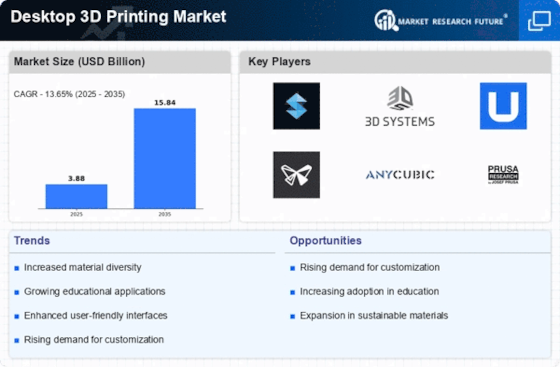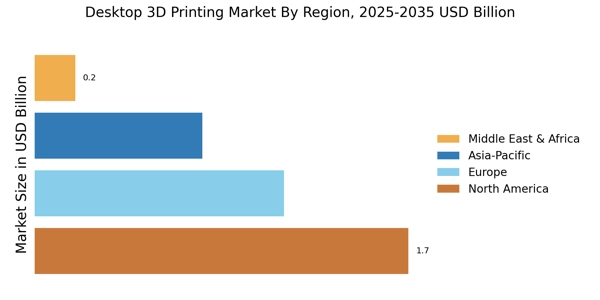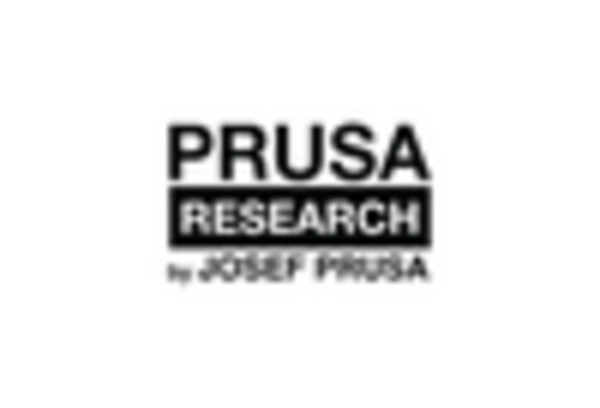Technological Advancements
The Desktop 3D Printing Market is experiencing rapid technological advancements that enhance printing capabilities and efficiency. Innovations in materials, such as bio-based filaments and high-strength composites, are expanding the range of applications for desktop 3D printers. Furthermore, improvements in software algorithms and user interfaces are making these devices more accessible to non-experts. According to recent data, the introduction of faster printing speeds and higher resolution outputs has led to a surge in adoption rates among small businesses and educational institutions. This trend indicates a shift towards more sophisticated and versatile 3D printing solutions, which could potentially reshape the landscape of the Desktop 3D Printing Market.
Educational Sector Adoption
The Desktop 3D Printing Market is significantly influenced by the increasing adoption of 3D printing technologies in educational institutions. Schools and universities are integrating desktop 3D printers into their curricula to enhance learning experiences in fields such as engineering, design, and art. This trend is evidenced by a rise in educational grants and funding aimed at acquiring 3D printing equipment. Data suggests that educational institutions that incorporate 3D printing into their programs see improved student engagement and creativity. As more educators recognize the value of hands-on learning, the Desktop 3D Printing Market is likely to benefit from sustained investment and interest from the education sector.
Growing Demand in Prototyping
The Desktop 3D Printing Market is witnessing a growing demand for rapid prototyping across various sectors, including automotive, aerospace, and consumer goods. Companies are increasingly utilizing desktop 3D printers to create prototypes that facilitate design iterations and reduce time-to-market. This trend is supported by data indicating that businesses that adopt 3D printing for prototyping can reduce development costs by up to 50%. As industries seek to innovate and streamline their processes, the reliance on desktop 3D printing for prototyping is likely to expand, further driving growth in the market. The ability to produce functional prototypes quickly and affordably positions the Desktop 3D Printing Market as a critical component in modern manufacturing.
Rise of Small-Scale Manufacturing
The Desktop 3D Printing Market is experiencing a notable rise in small-scale manufacturing, driven by the ability of desktop 3D printers to produce low-volume, customized products. Entrepreneurs and small businesses are leveraging these technologies to create unique items that cater to niche markets. This shift is supported by data indicating that small-scale manufacturers can achieve significant cost savings and reduced lead times compared to traditional manufacturing methods. As the trend towards localized production continues, the Desktop 3D Printing Market is poised for growth, as more businesses recognize the potential of 3D printing to meet specific consumer demands efficiently.
Sustainability and Eco-Friendly Practices
The Desktop 3D Printing Market is increasingly aligned with sustainability and eco-friendly practices, as consumers and businesses alike prioritize environmentally responsible solutions. The development of biodegradable and recyclable materials for 3D printing is gaining traction, appealing to a market that is becoming more conscious of its environmental impact. Data indicates that companies adopting sustainable practices in their manufacturing processes can enhance their brand image and attract eco-conscious consumers. As awareness of environmental issues continues to rise, the Desktop 3D Printing Market is likely to see a shift towards more sustainable production methods, which could redefine industry standards and practices.


















Leave a Comment